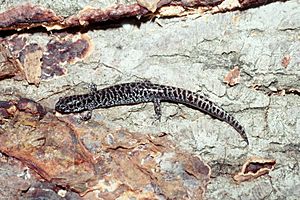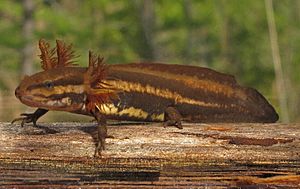Frosted flatwoods salamander facts for kids
Quick facts for kids Frosted flatwoods salamander |
|
|---|---|
 |
|
| Conservation status | |
| Scientific classification |
The frosted flatwoods salamander (Ambystoma cingulatum) is a small mole salamander. It usually grows to be about 9 to 13.5 centimeters (3.5 to 5.3 inches) long. This salamander has a small head, short legs, and a long, rounded tail.
Its body is usually brownish-black or purplish-black. It has thin gray or silvery-white markings that look like a net, or sometimes bands or spots. The young salamanders, called larvae, live in water and have cool brown and yellow stripes.
Where They Live
The frosted flatwoods salamander lives only in a small area in the southeastern United States. You can find them in parts of northern Florida, southern South Carolina, and southern Georgia. They live in pine flatwoods and pine savannas that get wet at certain times of the year. These areas are usually east of the Apalachicola River.
Long ago, these salamanders were common in forests with longleaf pine trees and wiregrass. These forests needed natural fires to stay healthy. But over time, many of these forests were replaced by cities, farms, and tree farms. One study showed that a large group of these salamanders disappeared when a natural pine forest was turned into a slash pine tree farm.
Changes in natural fire patterns have also hurt their homes. Fires that used to happen naturally in summer are now often stopped, and controlled fires are set in winter. This has changed the plants in the wetlands where the salamanders live. They no longer have the right plants for laying eggs or for the young salamanders to hide. Because of these changes, there are now very few frosted flatwoods salamanders left. They live in small, separate groups in Florida and Georgia, and are especially rare in South Carolina.
Life Cycle and Habits
Frosted flatwoods salamanders breed in shallow ponds that dry up at certain times of the year. These ponds often have pond cypress and black tupelo trees, along with different kinds of grasses and plants.
Adult salamanders spend most of the year underground. They live in burrows, often those made by crayfish. They probably eat small bugs and worms while they are underground.
From September to December, when it rains and cold weather arrives, adult salamanders move from the dry land to their breeding ponds. They find partners and lay eggs in the dry pond basins or in very shallow water. The female lays 100 to 200 eggs in small groups of 1 to 12. She usually places them among plants or in the entrances of crayfish burrows.
The eggs develop quickly. When the pond fills with water, the tiny salamanders hatch. The young salamanders, called larvae, live in the water for 11 to 24 weeks. They leave the ponds as "metamorphs" (young salamanders that have changed from larvae) between April and June. Males can start having babies when they are about 1 to 2 years old, and females when they are 2 to 3 years old.
Conservation Efforts
In 1999, the US Fish and Wildlife Service listed the flatwoods salamander as "Federally Threatened." This means it was in danger of becoming extinct. In 2007, scientists realized there were actually two different types of flatwoods salamanders: the frosted flatwoods salamander and the reticulated flatwoods salamander. The frosted flatwoods salamander kept its "Threatened" status. The reticulated flatwoods salamander (Ambystoma bishopi) was soon listed as "Federally Endangered," meaning it was in even greater danger. Even with these protections, the numbers of these salamanders continue to drop.



